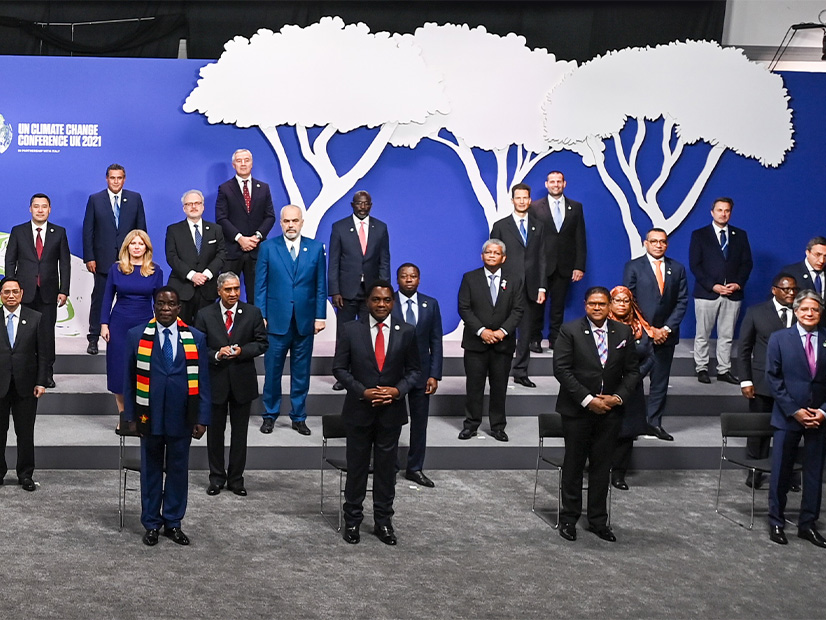
At the close of the U.N. Climate Change Conference (COP26) in Glasgow, Scotland, on Saturday, U.S. Special Presidential Envoy for Climate John Kerry optimistically announced that the world is closer than ever before to “avoiding climate chaos.”
“Paris was a signal to the marketplace, not a guarantee that we would be able to hold the Earth’s temperature rise to well below 2 degrees [Celsius], let alone 1.5 C,” he said in a press conference. “But in Glasgow, we have 65% of global GDP committed to real plans that have been certified by the IPCC [Intergovernmental Panel on Climate Change] and others.” (See related story, COP26 Ends: 1.5 C Still Alive, but ‘Pulse is Weak’.)
The U.S. and 150 other countries submitted updated nationally determined contributions (NDC) for COP26, and the Glasgow Climate Pact adopted by parties on Saturday urges parties to strengthen their 2030 targets by the end of next year. In addition to updating its NDC, the U.S. joined key sectoral initiatives on methane and deforestation, but it chose not to join pledges related to coal and zero-emission vehicle transitions.
Taking all NDCs, legally binding long-term climate targets and sectoral initiatives into consideration at the end of COP26, the result is that parties must do more to keep global temperature rise below 1.5 C.
If governments can achieve 2030 NDC and binding long-term and net-zero targets, temperature rise would be limited to 2.1 C, according to a Nov. 9 report from Climate Action Tracker (CAT). That estimate represents a 1.5-C reduction from CAT’s 2015 estimate when parties adopted the Paris Agreement.
With an IPCC benchmark of cutting emissions 45% below 2010 levels by 2030 for a 1.5-C warming target, the NDCs still leave an emission-reduction gap of 37 to 38%, according to the report. Sectoral pledges on methane, coal, transportation and deforestation — considering signatories as of Nov. 10 — close the emissions gap by an additional 9%, or 2.2 billion metric tons of carbon dioxide equivalent (GtCO2e).
Taken together, the NDCs, binding targets and sectoral initiatives leave an emission-reduction gap of 33 to 34%, the report said.
US Targets Methane, Deforestation
CAT estimated that the U.S.- and EU-led Global Methane Pledge launched Nov. 2 could reduce emissions by 0.8 GtCO2e in 2030. The agreement calls for a reduction in global anthropogenic methane emissions 30% below 2020 levels by 2030, but top emitting countries, including China, India and Russia, did not sign on to the initiative.
If all parties to the Paris Agreement were to sign on, CAT estimated they could achieve an additional 2.4-GtCO2e reduction. There currently are 110 participating countries. (See US, Canada, EU Pledge to Slash Methane Emissions.)
On Nov. 2, countries came together to support the Glasgow Leaders’ Declaration on Forests and Land Use, calling for an end to forest loss and land degradation by 2030. While the report cautioned that emissions from deforestation and land use are “highly uncertain,” it said the declaration could reduce emissions by 1.1 GtCO2e.
If all countries signed the agreement, it could reduce emissions by as much as 3 GtCO2e, the report said. As of Nov. 11, 140 countries, including the U.S., China and Russia, endorsed the declaration, covering 91% of the world’s forests.
US Dodges on Coal, Cars
The signatories to the U.K.-led Global Coal to Clean Power Transition statement could reduce emissions 2 GtCO2e by 2030, according to the report. Released on Nov. 4, the statement had the support of 46 countries, but China, the U.S., India and Russia were not among them.
Importantly, however, the statement includes specific clauses that some countries chose not to endorse.
One clause says signatories will transition away from unabated coal generation by 2040, or by 2030 for major economies. Another says signatories will no longer issue new permits and stop new construction for coal plants.
If all major economies phase out exist coal fleets by 2035, CAT estimated emissions would reduce by 0.8 GtCO2e. And canceling all coal plants in the global pipeline by 2030 would reduce emissions by 1.2 GtCO2e.
On the clean cars front, the U.S. chose not to support the Nov. 10 COP26 declaration on accelerating the transition to 100% zero-emission cars and vans. The declaration calls for new light-duty vehicles to be zero-emission by 2035 in leading markets and 2040 elsewhere. (See Calif. Supports New Clean Vehicle Pledges at COP26.)
With the initial 38 country signatories, the declaration could reduce emissions by 0.1 GtCO2e by 2030. If, however, major auto manufacturing countries, such as the U.S. and Germany, signed the declaration, additional emission reductions could reach 0.75 GtCO2e, the report said.

